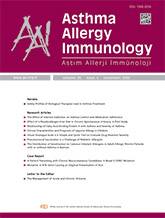


Objective: The knowledge concerning allergy to legumes is limited. We aimed to evaluate the clinical features and prognosis of legume allergy in children.
Materials and Methods: We evaluated patients with legume allergy who were followed up from 2010 to 2017 at the Division of Pediatrics Allergy and Immunology, with their clinical features, laboratory findings, and prognosis.
Results: The median age of the enrolled 37 patients in our study was 7 (interquartile range, 4.3-9.2) years. Twenty-nine (78.3%) were male. Thirteen (35.1%) patients were found to have an allergic reaction against more than one legume. The distribution of legume allergies was as follows: peanut (n=21, 56.8%), lentil (n=16, 43.2%), chickpea (n=13, 35.1%), pea (n=6,16.2%), bean (n=5, 13.5%), lupine (n=2, 5.4%), and kidney bean (n=1, 2.7%), with a total of 64 allergic reactions. The distribution of these different legume allergy reactions was as follows: urticaria and angioedema (n=31, 48.4%), anaphylaxis (n=23, 35.9%), atopic dermatitis (n=6, 9.3%), eosinophilic esophagitis (n=3, 7.8%), and food protein-induced enterocolitis syndrome (n=1, 1.5%). Thirty-two (86.5%) of 37 patients had an allergy to a non-legume food. Tolerance to 50 legume allergies affecting 27 patients being followed up for more than 12 months were given. Eight of the 18 patients with a single legume allergy and 1 of the 9 patients who were allergic to multiple legumes developed tolerance.
Conclusion: Peanut and lentil were the most frequent legumes that caused allergic reactions in our study. The rate of allergies to nonlegume foods was high. In patients who were allergic to a single legume, the tolerance rate was 44.4%.